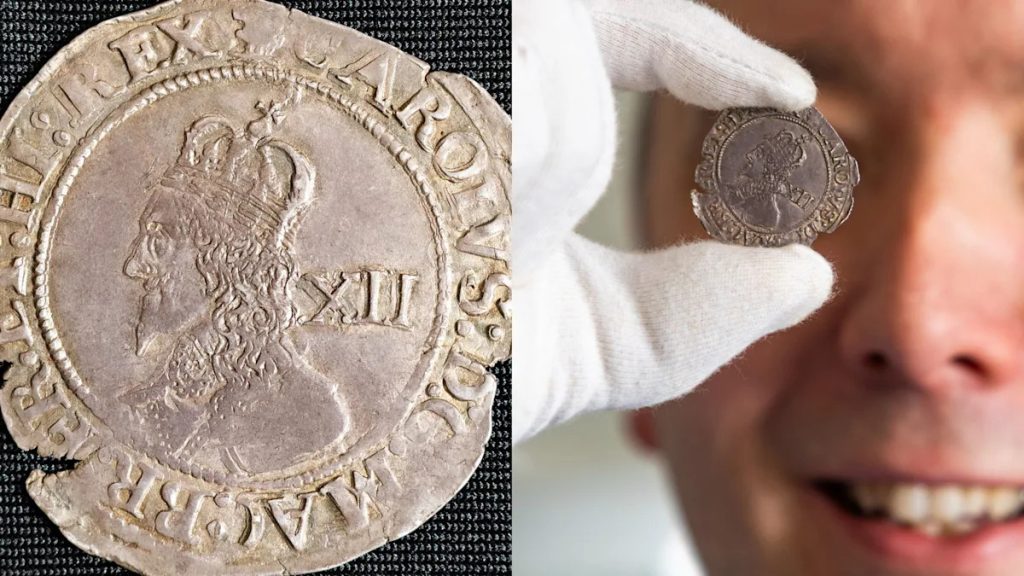Listen to the article
A rare 400-year-old coin that served as royal propaganda during the tumultuous English Civil War is expected to fetch more than £3,000 at an upcoming auction, experts revealed this week.
The 1643 Charles I Bristol shilling, considered extremely rare with only a handful known to exist, represents a significant artifact from one of Britain’s most pivotal historical periods. The coin was struck in Bristol following King Charles I’s Wellington Declaration, a crucial moment in the monarch’s conflict with Parliament.
“This isn’t just a coin – it’s an important piece of political propaganda and a tangible connection to Bristol’s complex history during the Civil War,” said Andrew Stowe, the auctioneer handling the sale. “Items of this historical significance and rarity seldom appear on the market.”
The English Civil War, which raged from 1642 to 1651, pitted Royalist supporters of King Charles I against Parliamentary forces, ultimately resulting in the king’s execution in 1649. During this period, control of the currency became a critical element in the struggle for power and legitimacy.
Bristol, a strategically vital port city, changed hands multiple times during the conflict. When under Royalist control, the city operated a mint that produced coins bearing the king’s image and royal symbols – a direct challenge to Parliament’s authority and a way to finance the war effort.
The Wellington Declaration, issued by Charles I in September 1642, marked the king’s formal call to arms. Following this proclamation, Royalist forces established mints in several cities to produce currency that reinforced the king’s claim to power. The Bristol mint became particularly important as one of the few facilities capable of producing silver coins of this quality during wartime conditions.
Numismatic experts note that Civil War-era coins have seen increasing collector interest in recent years, with prices climbing steadily as museums and private collectors compete for these historical treasures. The limited production and high attrition rate of these coins – many were melted down after Parliamentary victory – has made surviving examples increasingly valuable.
“What makes this particular shilling special is not just its age, but its remarkable condition and historical context,” explained Dr. Eleanor Phillips, a historian specializing in 17th-century British artifacts. “These coins were tools in an information war just as much as they were currency. The imagery and inscriptions were carefully designed to reinforce royal authority at a time when it was being actively challenged.”
The coin bears the distinctive portrait of Charles I along with Latin inscriptions asserting his divine right to rule – messaging that would have been instantly recognizable to citizens of the era as taking sides in the escalating conflict.
Bristol’s role in the Civil War adds another layer of significance to the artifact. The city initially declared for Parliament but was captured by Royalist forces in July 1643, leading to the establishment of the mint that produced this coin. The city later returned to Parliamentary control in September 1645, after which such Royalist coinage was suppressed.
The Charles I Bristol shilling will be offered by Auctioneum Ltd on November 19, with telephone and online bidding options available for collectors worldwide. Similar examples have consistently exceeded their pre-sale estimates at auction in recent years, reflecting the growing market for artifacts connected to this pivotal period in British history.
Collectors and institutions are expected to compete vigorously for this rare piece of numismatic history that bridges the worlds of currency, propaganda, and political upheaval during one of Britain’s most defining conflicts.
Fact Checker
Verify the accuracy of this article using The Disinformation Commission analysis and real-time sources.




8 Comments
The rarity of this Bristol shilling highlights how control of the currency was a critical element in the Civil War. It’s amazing that such a small object can still provide insight into these historic events.
I wonder if there are any other surviving examples of Civil War-era propaganda coins that offer a similar window into the conflict.
Fascinating historical artifact from a tumultuous period in English history. This 400-year-old propaganda coin offers a unique window into the power struggle between the Crown and Parliament during the Civil War.
I’m curious to learn more about the specific political messaging this coin was intended to convey at the time.
The fact that only a handful of these coins are known to exist underscores their rarity and historical significance. This is a truly unique opportunity for collectors and historians alike.
This coin is a fascinating piece of history, but I hope the auction house is able to ensure it ends up in a museum or institution where it can be properly preserved and studied by historians.
It’s remarkable that this 400-year-old coin has survived to the present day. Artifacts like this offer valuable primary source material for understanding the complex political and economic dynamics of the English Civil War.
I wonder if there are any insights this coin could provide about the role of currency control and propaganda in the broader conflict between the Crown and Parliament.